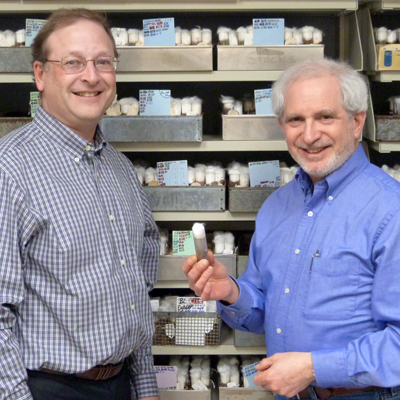Small flies help provide big answers about traumatic brain injury
Most common in sports, car accidents, and falls, traumatic brain injury (TBI) can result in severe short-term and long-term consequences for affected individuals. It is the leading cause of death for people under the age of 45 in the US, and 2.5-6.5 million people are living with the consequences of TBI, including both neurological and non-neurological disorders. Unfortunately, there are no therapies currently available to improve TBI outcomes. Since 1985, at least 21 clinical trials have been conducted, and none have shown a significant benefit, potentially due to the highly complex series of molecular events triggered by TBI. Drs. Barry Ganetzky and David Wassarman, at the University of Wisconsin-Madison, have developed new ways to study TBI using Drosophila (fruit flies) as a simple experimental model. With this model, Drs. Ganetzky and Wassarman hope to understand how cellular and molecular pathways are affected and altered by TBI, which will ultimately help develop therapies to reduce its consequences.
These two investigators have a long history of influential research using Drosophila, much of which has had an important impact on human disease. Experts in Genetics and Molecular Biology, respectively, Drs. Ganetzky and Wassarman possess a deep understanding of Drosophila, its advantages as an experimental organism and its biological systems. Now, they have combined their expertise to pioneer a cutting-edge line of research, using for the first time, a simple invertebrate organism as opposed to vertebrate rodent models to investigate TBI. Drosophila is unique in that it enables almost unlimited experimental capabilities as well as accuracy and reproducibility; the functions, structure, and the mechanisms of its nerve cells are almost exactly like those of humans; and numerous breakthroughs from Drosophila research have been directly applicable to people. The fruit fly model therefore provides the experimental means to rapidly identify genes and biological events that are central to the causes and the consequences of TBI.
Some of the current areas of research include:
- Biomarkers for TBI: A major roadblock to the diagnosis and treatment of TBI is the inability to objectively measure the severity of brain damage immediately following an incident and the progression of brain deterioration that follows. The Ganetzky and Wassarman team can use genetic and biochemical methods in flies to identify proteins and other molecules that reflect biological responses to TBI and can be detected non-invasively, quantitatively, and rapidly.
- Brain cell dysfunction in TBI: Multiple TBI incidents can promote a neurodegenerative brain disorder called chronic traumatic encephalopathy (CTE), which is similar in appearance and consequences to Alzheimer’s disease. It is yet to be determined how mechanical injury to the brain triggers CTE years after the initial injuries. Drs. Ganetzky and Wassarman can use the fly TBI model to determine the pathway of events by which TBI causes the progressive dysfunction of brain cells in CTE.
- TBI and aging: The consequences of TBI are more severe in older individuals than younger individuals presumably because something happens during the aging process that enhances the effects of TBI. In addition, many of the physiological consequences of TBI are similar to those that generally occur during the normal aging process. Because flies live a short time (50-100 days), they can easily be studied over their entire lifespan to identify the relevant links between aging and TBI. The Ganetzky and Wassarman team have already determined that age affects the consequences of TBI in flies and they can now determine what happens during aging that intensifies the effects of TBI.
- TBI therapeutics: Currently, there are no drugs that block or even reduce the consequences of TBI. Because large numbers of flies can be examined in a short period of time, the Ganetzky and Wassarman team can test thousands of compounds on flies subjected to TBI to identify those with potential therapeutic benefit in humans. They can also take a more targeted approach to test drugs that are known to inhibit or modify the activity of specific proteins whose role in TBI they have uncovered.
Bio
Even as a child, Dr. Barry Ganetzky had a relentless curiosity that was rarely satisfied by standard answers provided by parents or teachers. Ultimately, he learned that it was through science—asking questions, doing experiments to test ideas, rejecting those that could not be supported by rigorous evidence—that we were able to gain understanding of our world and life in particular, and this fascination with life led to an undergraduate degree in biology, during which he fell in love with Genetics—a love that has not diminished for over 45 years.
Pursuing biological research with a Ph.D. in Genetics at the University of Washington in Seattle, Dr. Ganetzky became deeply involved in the art of Drosophila genetics. Here, he learned how to take advantage of all the useful features of this organism, to conduct breeding experiments and the variety of ways we could manipulate the genes and chromosomes of Drosophila to find answers to fundamental biological questions. Beyond his particular thesis project, he was in an environment surrounded by outstanding geneticists working on a variety of organisms, using genetic approaches to unravel a host of important biological problems.
He continued to strengthen his expertise in Drosophila genetics, eventually becoming the first to identify mutations affecting ion channels. These and other discoveries have had a significant impact on understanding basic neurobiological mechanisms, human disease, and the pharmaceutical industry. He has served as the President of the Genetics Society of America and was elected as a fellow of the American Association for the Advancement of Science and as a member of the National Academy of Sciences. Throughout his career, Dr. Ganetzky came to strongly believe in the importance of basic research as fundamental to understanding and finding cures for human disease.
Dr. David Wassarman thoroughly agrees with Dr. Ganetzky on the importance of basic research; in fact, he became a basic researcher because he finds it extremely rewarding to figure out how biological systems work. “Part of the reward comes from knowing that fundamental knowledge of biological systems will ultimately make possible the development of approaches to cure diseases,” he remarks. He has worked on a variety of research problems through his career. As a graduate student at Yale University, he used molecular approaches to understand how small RNAs regulate gene expression in human cells. Then, as a postdoctoral fellow at the University of California, Berkeley, he used genetic approaches in Drosophila to investigate the workings of the cancer-causing gene Ras.
These studies led Dr. Wassarman to a position as an Investigator at the National Institutes of Health (NIH), where he studied epigenetic processes that regulate gene expression. In 2001, Dr. Wassarman moved to the University of Wisconsin-Madison, where he continually draws upon each of his prior experiences to achieve the goal of understanding the complex molecular and cellular events that underlie neurodegenerative diseases. He finds his research on traumatic brain injury (TBI) to be particularly engaging, because so little is known about how mechanical damage to neurons leads to a broad spectrum of physiological defects that arise over time.
Drs. Ganetzky and Wassarman have been colleagues as faculty members at the University of Wisconsin-Madison who shared a similar interest in Drosophila and the normal mechanisms that underlie neurodegeneration. In the past 5-7 years, they had been interacting substantially to work on neurodegeneration models in fruit flies, trying to understand what happens in aging flies and what happens in various disease conditions that are genetic in origin. Although they had been working on different neurodegeneration models at the time, an idea came when Dr. Ganetzky was reading about the suicide of one of the football players having suffered the consequences of TBI. This was an environmental cause, not genetic. “How useful will it be if we could develop a TBI model in fruit flies, and how come no one has done that before?” Dr. Ganetzky wondered, and knowing Dr. Wassarman’s scientific rigor, he decided to ask Dr. Wassarman about his thoughts.
Dr. Wassarman’s enthusiasm then provided the strong motivation for Dr. Ganetzky to move beyond contemplation and to carry out an action. “I probably would have spent more time thinking, but David just went ahead and did it -- he got the data and pushed us forward,” Dr. Ganetzky remarks. Combining their fields of expertise that overlap but that aren’t quite the same, Drs. Ganetzky and Wassarman have different perspectives, tools, and techniques to offer. Their complementary qualities indeed create a unique and strong synergy, and the fly model of TBI that the Ganetzky and Wassarman team have developed is the first, and the only model of closed head injuries in the fly. Contemporary leaders with robust professional background, Drs. Ganetzky and Wassarman are pioneering a field that will not only inspire other sectors of research but also help alleviate the burdens of those afflicted.
In the News
University of Wisconsin--Madison School of Medicine and Public Health; An interview with Dr. Wassarman about the fly TBI model
Publications
Videos
Awards
NIH Career Development Award, 1982-1987
This award from NIH is aimed at promoting the research of promising young scientists at an early stage in their careers by providing funding that frees them from most teaching and administrative responsibilities so they can focus on developing their research programs
Steenbock Professorship in the Biological Sciences, 1995-2015
The Steenbock Professorships in the Natural Sciences are among the most prestigious endowed chairs that can be held at the University of Wisconsin. An outside committee of experts from U.S. and Canadian universities make the final selections in each case. The initial award is for a period of ten years after which the selection committee chooses the awardee for the ensuing ten years
Elected to the National Academy of Sciences, 2006
Each year 84 new members across all fields of science are elected by current members to the National Academy of Sciences in recognition of their distinguished and continuing achievements in research. Election to the National Academy is considered one of the highest professional honors among scientists.
University of Illinois-Chicago Alumni Achievement Award, 2012
This award is the highest honor bestowed upon alumni of the University of Illinois by the Alumni Association on behalf of the University. The award is presented to those alumni who have attained outstanding success and national or international distinction in their chosen profession or life’s work, and whose accomplishments reflect admirably on, or bring honor to, their Alma Mater.
UW-Madison Hilldale Award in Biological Sciences, 2013
Four Hilldale Awards are presented annually by the University of Wisconsin-Madison in each of the university’s four divisions--biological sciences, physical sciences, social studies, and arts and humanities--in recognition of outstanding contributions to teaching, research and service
Vilas Associate, The Graduate School, University of Wisconsin-Madison, 2012-2014
Presidential Early Career Award for Scientists and Engineers, 1997-2002
Helen Hay Whitney Postdoctoral Fellowship, 1993-1996
Patents
U.S. Patent Appl. No. 20140377183: "Methods, systems, and devices for an invertebrate model of traumatic brain injury."
Ganetzky, B. and D. A. Wassarman. Filed: June 25, 2014. Issued: December 25, 2014.
U. S. Patent No. 7,060,249B2: "Neurodegeneration mutants, method for identifying same and method of screening for neuroprotective agents."
Ganetzky, B. and M. J. Palladino 2006. (pending)
U.S. Patent Appl. No. 20140283149: "In vivo cellular screening methods and compositions for modeling and treating nervous system dysfunction."
Ganetzky, B., Miller, D. and S. Ballard. Filed: March 14, 2014. Issued: September 18, 2014.
U.S. Patent Appl. No. 20140377183: "Methods, systems, and devices for an invertebrate model of traumatic brain injury."
Ganetzky, B. and D. A. Wassarman. Filed: June 25, 2014. Issued: December 25, 2014.


